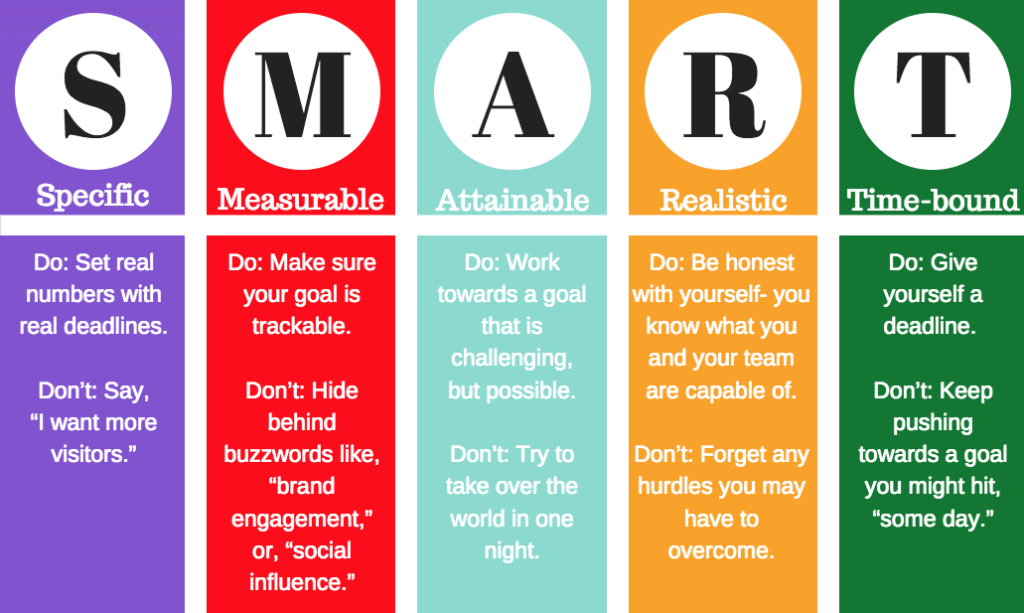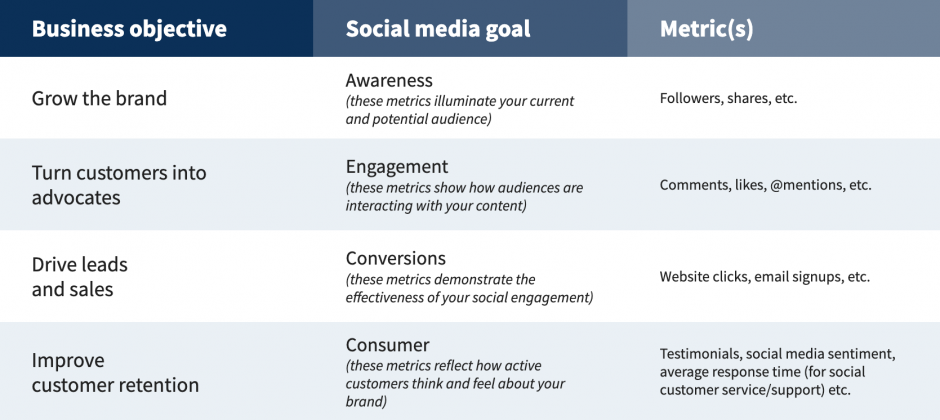Creating a marketing strategy for social media doesn’t have to be painful. Here’s an eight-step guide to build a successful social media strategy.
A social media strategy is a list of everything on social media that you expect to do and intend to accomplish. It controls your performance and lets you know whether you’re losing or succeeding.
The more detailed your strategy is the more effective it is going to be. Hold this concisely. Don’t make it so high and wide that it’s unattainable or impractical to evaluate.
We’ll guide you through an eight-step process in this post to build your own winning social media marketing strategy.
Contents
How will a social media strategy be created?
Step 1. Choose social media content goals that correspond with company objectives.
Set the priorities of S.M.A.R.T.

The first move in developing a winning approach is to set your priorities and targets. Without targets, you have no way to calculate success and return on investment (ROI).
Any of the priorities should be as follows:
- Specifically (Specific)
- Measurable
- Achievable (Attainable)
- Relevant (Realistic)
- Time-bound
This is the objective structure of the S.M.A.R.T. It will direct your decisions and ensure that they produce real business outcomes.
Track important metrics
Vanity metrics like the number of followers and shares are easy to track, but it’s hard to prove their true worth. Instead, concentrate on items like interaction, click-through, and conversions.
You may want to track various targets for different networks, or also different uses for each network.
For eg, if you use LinkedIn to push traffic to your website, you will be able to calculate click-throughs. If Instagram is for brand recognition, you might want to watch the amount of Instagram Story views. And if you’re ads on Facebook, cost-per-click (CPC) is a typical performance metric.
Social media plans should be aligned with the overall marketing objectives. This makes it easy to show the value of your position and gain buy-in from your manager.
The map demonstrating how social media goals can be matched with company objectives.

Start creating the social media marketing strategy by writing at least three social media targets.
Step 2. Know what the audience would do
Building audience personas
It’s important to know who the audience is and what they want to see on social media. You will generate content that they appreciate, comment on, and share in that same way. It’s also important if you want to turn social media fans into business customers.
You should know stuff like when it comes to your target customer:
- Their Age
- City, Location
- Their income
- Typical job title or business
- Their Interests
Get to know your fans, friends, and clients as real people with real desires and wishes, and you’ll know how to target and connect them on social media.
Collect data
Don’t make conclusions on that. Think Facebook is a better network to target Baby Boomers than Millennials?
Ok, the numbers reveal that Millennials already outnumbers the Boomers on the platform.
Analytics on social media will also include a lot of insightful knowledge about who your followers are where they live and how they communicate on social media with your brand. These observations allow you to optimize your strategy and to grow your audience better.
Step 3. Get to know the competitors
Odds are that the rivals are also using social media, and that means you can benefit from what they’re doing.
Carry out a competitive review
The strategic analysis helps you to consider who the competition is and what the competitor is doing well (and not so well). You’ll get a strong idea of what’s expected in your industry, which will help you set your own social media goals.
It’s all going to help you find opportunities.
Perhaps one of the rivals is dominant on Facebook, for example, but has made no effort on Twitter or Instagram. You would want to concentrate on the platforms where your audience is under-served, rather than attempting to win viewers away from the dominant player.
Step 4. Do an audit on social media
Take account of your efforts so far if you’re still using social media. Ask yourself the questions below:
- What does work, and what doesn’t?
- Who’s actively participating with you?
- What networks are being used for your target audience?
- How does your presence on social media compare to the competitors?
You’ll be able to start thinking about how to change once you gather the knowledge.
our audit should give you a good view of how each of your social media performs its function. If the intent of the account is not clear, consider whether it is good to hold.
Ask yourself to decide on the following questions:
Will there an audience for me?
If so, how is this platform used by them?
May I use this account to help fulfill my objectives?
Asking these difficult questions will keep the approach centered.
Check into accounts for the impostor
You can find fake accounts using your company name or the names of your products during the audit.
These imposters may be negative to your brand—never mind grabbing followers who should be yours.
Please report them.
You want to update and be certain that your fans know they are dealing with you on Facebook and Twitter as well as Instagram.
Step 5. Account configuration and profile optimization
Makes the decision which platforms to use
You would also need to identify the plan for each when you determine which social networks to use.
For example, here’s how other small and medium-sized companies use social tools to engage with clients. Note that for this reason, Facebook and Instagram outrank even email.
Customize the profiles
When you decide which platforms to work on it’s time to build your profiles. Or upgrade current ones so they fit with your strategy.
Make sure all profile fields are filled out.
Include keywords that users can use to scan into your product
Use clear branding across networks (logos, pictures, etc. to make the accounts instantly identifiable.
Step 6. Look for inspiration now
Although your brand must be exclusive, you can also take influence from other social companies.
Success stories in social media
You will normally find them on the business section of the website of the social network. (Here’s Facebook, for example.)
Case studies will provide useful information that you can add to your own social media strategy.
Asking the followers
Consumers will also inspire social media.
What are your key customers writing about online? How do you learn regarding their expectations and wants?
If you have established social media, you can even ask your fans what they expect from you. Only make sure you follow through and deliver what they’re looking for.
Step 7. Create a calendar of social media content
Producing great content is necessary of course, but it is also crucial to have a strategy in place to distribute content to have the greatest effect.
Your social media marketing calendar also needs to take into account the time you spend engaging with your audience (although you need to allow for some spontaneous engagement as well).
Set your timetable for posting
Your social media marketing calendar details the dates and times at which you can post content types on each channel. It’s the best place to plan all your social media activities—from photos and posting references to blog posts and videos. This covers all your daily posting and material for social media promotions.
Your calendar also guarantees that your blogs are properly spread out and distributed at an ideal time.
Step 8. Evaluating and changing your strategy
Your social media strategy is an enormously critical document for your company, and on the first try, you can’t assume you’ll get it exactly right. You will discover that some methods do not perform as well as you expected, while others work much better than expected, as you continue to execute your strategy and monitor your outcomes.
Re-evaluating, checking, and doing it once again
When this input starts rolling in, use it to periodically re-evaluate the strategy. To test various posts, promotions, and tactics against each other, you can also use this knowledge. Constant monitoring helps you to learn what functions and what doesn’t, meaning that in real-time you can improve your strategy.
Surveys can also be an ideal way to figure out how good the approach performs. Ask your fans, email list, and guests to the website if you fulfill their desires and aspirations, and what else they would like to see. Then make sure that what they say to you is delivered.
Social network changes quickly. New networks are emerging, most are going by generational changes.
Your business will also go through phases of transformation.
All of this suggests that a living document that you study and change if appropriate should be your social media strategy. To keep on track, return to it regularly, but don’t be afraid to make improvements so that new goals, resources, or strategies are best expressed.
Be sure to let everyone on your team know when you change your social plan. They will all work together in this way to help the company make the best of your accounts.





